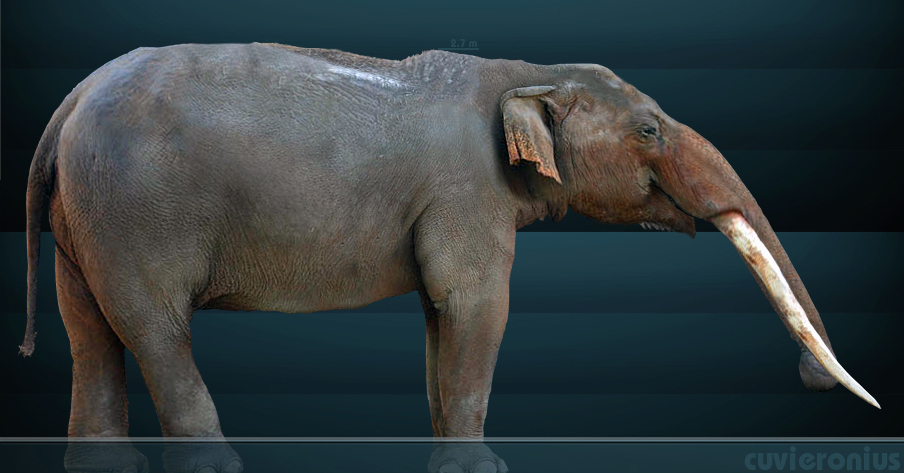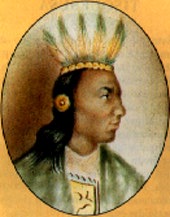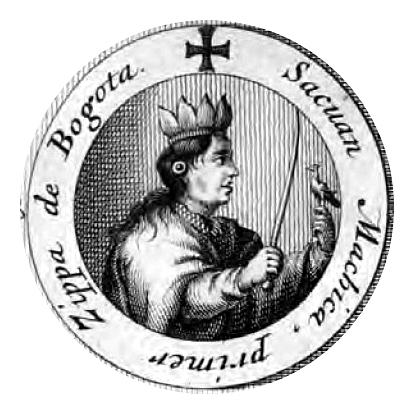|
Meicuchuca
Meicuchuca (died 1470) was the first ruler (''zipa'') of Bacatá, as of around 1450. His ''zaque'' counterpart ruling over the northern area of the Muisca territory was Hunzahúa. Biography Little is known about Meicuchuca and many stories about his reign are more mythical than historical. He ruled the southern Muisca territory from around 1450 to 1470 and was succeeded according to Muisca heritage laws by his nephew Saguamanchica. Meicuchuca and the snake The legend of Meicuchuca and the snake tells the story of the ''zipa'' who already had many wives. Polygamy was common practice with the Muisca and the higher the rank, the more wives could be held. The highest position of ''zipa'' could allow to have and sustain 300 wives, while the lower rank ''cacique'' "only" made 100 wives possible. Meicuchuca allegedly fell in love with a woman outside of the Muisca community. He only had eye for her and spent day and night with the beautiful stranger, forgetting all his other wives. ... [...More Info...] [...Related Items...] OR: [Wikipedia] [Google] [Baidu] |
Bacatá
Bacatá is the name given to the main settlement of the Muisca Confederation on the Bogotá savanna. It mostly refers to an area, rather than an individual village, although the name is also found in texts referring to the modern settlement of Funza, in the centre of the savanna. Bacatá, alternatively written as Muequetá or Muyquytá, was the main seat of the ''zipa'', the ruler of the Bogotá savanna and adjacent areas. The name of the Colombian capital, Bogotá, is derived from Bacatá, but founded as Santafe de Bogotá in the western foothills of the Eastern Hills, Bogotá, Eastern Hills in a different location than the original settlement Bacatá, west of the Bogotá River, eventually named after Bacatá as well. The word is a combination of the Chibcha language, Chibcha words ''bac'', ''ca'' and ''tá'', and means "(enclosure) outside the farmfields", referring to the rich Muisca agriculture, agricultural lands of the Sabana Formation on the Bogotá savanna. Bacatá was sub ... [...More Info...] [...Related Items...] OR: [Wikipedia] [Google] [Baidu] |
Muisca Confederation
The Muisca Confederation was a loose confederation of different Muisca rulers (''zaques'', ''zipas'', '' iraca'', and ''tundama'') in the central Andean highlands of present-day Colombia before the Spanish conquest of northern South America. The area, presently called Altiplano Cundiboyacense, comprised the current departments of Boyacá, Cundinamarca and minor parts of Santander. According to some Muisca scholars the Muisca Confederation was one of the best-organized confederations of tribes on the South American continent. Modern anthropologists, such as Jorge Gamboa Mendoza, attribute the present-day knowledge about the confederation and its organization more to a reflection by Spanish chroniclers who predominantly wrote about it a century or more after the Muisca were conquered and proposed the idea of a loose collection of different people with slightly different languages and backgrounds.Gamboa Mendoza, 2016 Geography Climate Muisca Confederation In the time ... [...More Info...] [...Related Items...] OR: [Wikipedia] [Google] [Baidu] |
Zipa
When the Spanish arrived in the central Colombian highlands, the region was organized into the Muisca Confederation, which had two rulers; the ''zipa'' was the ruler of the southern part and based in Muyquytá. The ''hoa'' was the ruler of the northern area and based in Hunza, known today as Tunja. Organization ''Psihipqua'' and ''hoa'' were the titles given to these rulers of the ancient confederation. Neither exercised absolute power, not rigid or strict control over those to whom they owed their power, so that they can be considered kings. However, these positions of power were of great honor and were surrounded by a rather elaborate ceremony. The position of the ''psihipqua'' was such that not even the members of the nobility dared to look him in the face, and it is said if the ''psihipqua'' needed to spit, someone would hold out a piece of rich cloth for him to spit on, because it would be sacrilegious for anything so precious as his saliva to touch the ground. Whoever hel ... [...More Info...] [...Related Items...] OR: [Wikipedia] [Google] [Baidu] |
Muisca Rulers
When the Spanish arrived in the central Colombian highlands, the region was organized into the Muisca Confederation, which had two rulers; the ''zipa'' was the ruler of the southern part and based in Muyquytá. The ''hoa'' was the ruler of the northern area and based in Hunza, known today as Tunja. Organization ''Psihipqua'' and ''hoa'' were the titles given to these rulers of the ancient confederation. Neither exercised absolute power, not rigid or strict control over those to whom they owed their power, so that they can be considered kings. However, these positions of power were of great honor and were surrounded by a rather elaborate ceremony. The position of the ''psihipqua'' was such that not even the members of the nobility dared to look him in the face, and it is said if the ''psihipqua'' needed to spit, someone would hold out a piece of rich cloth for him to spit on, because it would be sacrilegious for anything so precious as his saliva to touch the ground. Whoever hel ... [...More Info...] [...Related Items...] OR: [Wikipedia] [Google] [Baidu] |
Saguamanchica
Saguamanchica (died Chocontá, 1490) was the second ruler (''zipa'') of Muyquytá, as of 1470. His ''zaque'' enemy ruling over the northern area of the Muisca territory was Michuá. Alternative spellings of his name are Sacuan Machica, Saguanmachica and Saguanmanchica. Biography As former ''cacique'' of Chía, Saguamanchica accessed the throne of the southern Muisca around 1470. His predecessor, the first ''zipa'' of Muyquytá Meicuchuca, left him a rich kingdom with many guecha warriors. This led Saguamanchica to seek expansion of his ''zipazgo''. The first campaign of warfare he planned was to submit the eternal enemies of the Muisca, the Panche and the Sutagao to the west of the Muisca territories. The Carib-speaking peoples formed an alliance against their common and far outnumbered enemy. Saguamanchica together with his vassal Pasca defeated his enemies led by general Uzatama with ease and annexed Fusagasugá and Tibacuy. The expansion policies of the southern Muisc ... [...More Info...] [...Related Items...] OR: [Wikipedia] [Google] [Baidu] |
Zaque
When the Spanish arrived in the central Colombian highlands, the region was organized into the Muisca Confederation, which had two rulers; the ''zipa'' was the ruler of the southern part and based in Muyquytá. The ''hoa'' was the ruler of the northern area and based in Hunza, known today as Tunja. Organization ''Psihipqua'' and ''hoa'' were the titles given to these rulers of the ancient confederation. Neither exercised absolute power, not rigid or strict control over those to whom they owed their power, so that they can be considered kings. However, these positions of power were of great honor and were surrounded by a rather elaborate ceremony. The position of the ''psihipqua'' was such that not even the members of the nobility dared to look him in the face, and it is said if the ''psihipqua'' needed to spit, someone would hold out a piece of rich cloth for him to spit on, because it would be sacrilegious for anything so precious as his saliva to touch the ground. Whoever hel ... [...More Info...] [...Related Items...] OR: [Wikipedia] [Google] [Baidu] |
Muisca People
The Muisca (also called Chibcha) are an indigenous people and culture of the Altiplano Cundiboyacense, Colombia, that formed the Muisca Confederation before the Spanish conquest. The people spoke Muysccubun, a language of the Chibchan language family, also called ''Muysca'' and ''Mosca''. They were encountered by conquistadors dispatched by the Spanish Empire in 1537 at the time of the conquest. Subgroupings of the Muisca were mostly identified by their allegiances to three great rulers: the '' hoa'', centered in Hunza, ruling a territory roughly covering modern southern and northeastern Boyacá and southern Santander; the '' psihipqua'', centered in Muyquytá and encompassing most of modern Cundinamarca, the western Llanos; and the ''iraca'', religious ruler of Suamox and modern northeastern Boyacá and southwestern Santander. The territory of the Muisca spanned an area of around from the north of Boyacá to the Sumapaz Páramo and from the summits to the western p ... [...More Info...] [...Related Items...] OR: [Wikipedia] [Google] [Baidu] |
Hunzahúa
Hunzahúa was the first ''zaque''; ruler of the northern Muisca with capital Hunza, named after him. His contemporary ''zipa'' of the southern Muisca was Meicuchuca. Biography Hunzahúa, heir of Idacansás, was a ''cacique'' in the sacred valley of the ''iraca'' and was chosen by the other ''caciques'' of the region to make peace between the battling parties. He became the first ''zaque'' of the northern Muisca region based in Hunza, present-day Tunja, and one of his policies was the ban on the use of weapons. According to Muisca scholar Javier Ocampo López, who wrote extensively about the religion and mythology of the Muisca, his mother was named Faravita and his sister Noncetá. Legend tells that Hunzahúa fell in love with his older sister and made her his wife when he left Hunza for Chipatá. Faravita, the mother of the ''zaque'', disagreed with the marriage of her two children and attacked the couple, spilling a bowl of chicha. This created the Hunzahúa Well. When Hunzah� ... [...More Info...] [...Related Items...] OR: [Wikipedia] [Google] [Baidu] |
Muisca Mythology And Religion
The Muisca (also called Chibcha) are an indigenous peoples of Colombia, indigenous people and Pre-Columbian cultures of Colombia, culture of the Altiplano Cundiboyacense, Colombia, that formed the Muisca Confederation before the Spanish conquest of the Muisca, Spanish conquest. The people spoke Muysccubun, a language of the Chibchan languages, Chibchan language family, also called ''Muysca'' and ''Mosca''. They were encountered by list of conquistadors in Colombia, conquistadors dispatched by the Spanish Empire in 1537 at the time of the Spanish conquest of the Muisca, conquest. Subgroupings of the Muisca were mostly identified by their allegiances to three great rulers: the ''zaque, hoa'', centered in Tunja, Hunza, ruling a territory roughly covering modern southern and northeastern Boyacá Department, Boyacá and southern Santander Department, Santander; the ''zipa, psihipqua'', centered in Bacatá, Muyquytá and encompassing most of modern Cundinamarca Department, Cundinama ... [...More Info...] [...Related Items...] OR: [Wikipedia] [Google] [Baidu] |
15th Century In Colombia
15 (fifteen) is the natural number following 14 and preceding 16. Mathematics 15 is: * A composite number, and the sixth semiprime; its proper divisors being , and . * A deficient number, a smooth number, a lucky number, a pernicious number, a bell number (i.e., the number of partitions for a set of size 4), a pentatope number, and a repdigit in binary (1111) and quaternary (33). In hexadecimal, and higher bases, it is represented as F. * A triangular number, a hexagonal number, and a centered tetrahedral number. * The number of partitions of 7. * The smallest number that can be factorized using Shor's quantum algorithm. * The magic constant of the unique order-3 normal magic square. * The number of supersingular primes. Furthermore, * 15 is one of two numbers within the ''teen'' numerical range (13-19) not to use a single-digit number in the prefix of its name (the first syllable preceding the ''teen'' suffix); instead, it uses the adjective form of five (''fif' ... [...More Info...] [...Related Items...] OR: [Wikipedia] [Google] [Baidu] |
1470 Deaths
147 may refer to: * 147 (number), a natural number * AD 147, a year of the Julian calendar, in the second century * 147 BC, a year of the pre-Julian Roman calendar * 147 AH, a year in the Islamic calendar that corresponds to 764 – 765 CE In the military * BQM-147 Dragon unmanned aerial vehicle, a tactical battlefield UAV operated by the US Marine Corps * Ryan Model 147 Lightning Bug was a drone, or unmanned aerial vehicle during the 1960s * was a United States Navy Admirable-class minesweeper during World War II * was a United States Navy Edsall-class destroyer escort during World War II * was a United States Navy Haskell-class attack transport during World War II * was a United States Navy ''General G. O. Squier''-class transport ship during World War II * was a United States Navy Wickes-class destroyer during World War II * was a United States Navy ''Neosho''-class fleet oiler of the United States Navy during the Six-Day War Science and medicine * 147 Protogeneia, a ... [...More Info...] [...Related Items...] OR: [Wikipedia] [Google] [Baidu] |
History Of Colombia
The history of Colombia includes the settlements and society by indigenous peoples, most notably, the Muisca Confederation, Quimbaya Civilization, and Tairona Chiefdoms; the Spanish arrived in 1492 and initiated a period of annexation and colonization, most noteworthy being Spanish conquest; ultimately creating the Viceroyalty of New Granada, with its capital at Bogotá. Independence from Spain was won in 1819, but by 1830 the "Gran Colombia" Federation was dissolved. What is now Colombia and Panama emerged as the Republic of New Granada. The new nation experimented with federalism as the Granadine Confederation (1858), and then the United States of Colombia (1863), before the Republic of Colombia was finally declared in 1886; as well as constant political violence in the country. Panama seceded in 1903. Since the 1960s, the country has suffered from an asymmetric low-intensity armed conflict, which escalated in the 1990s, but then decreased from 2005 onward. The legacy of Colo ... [...More Info...] [...Related Items...] OR: [Wikipedia] [Google] [Baidu] |








